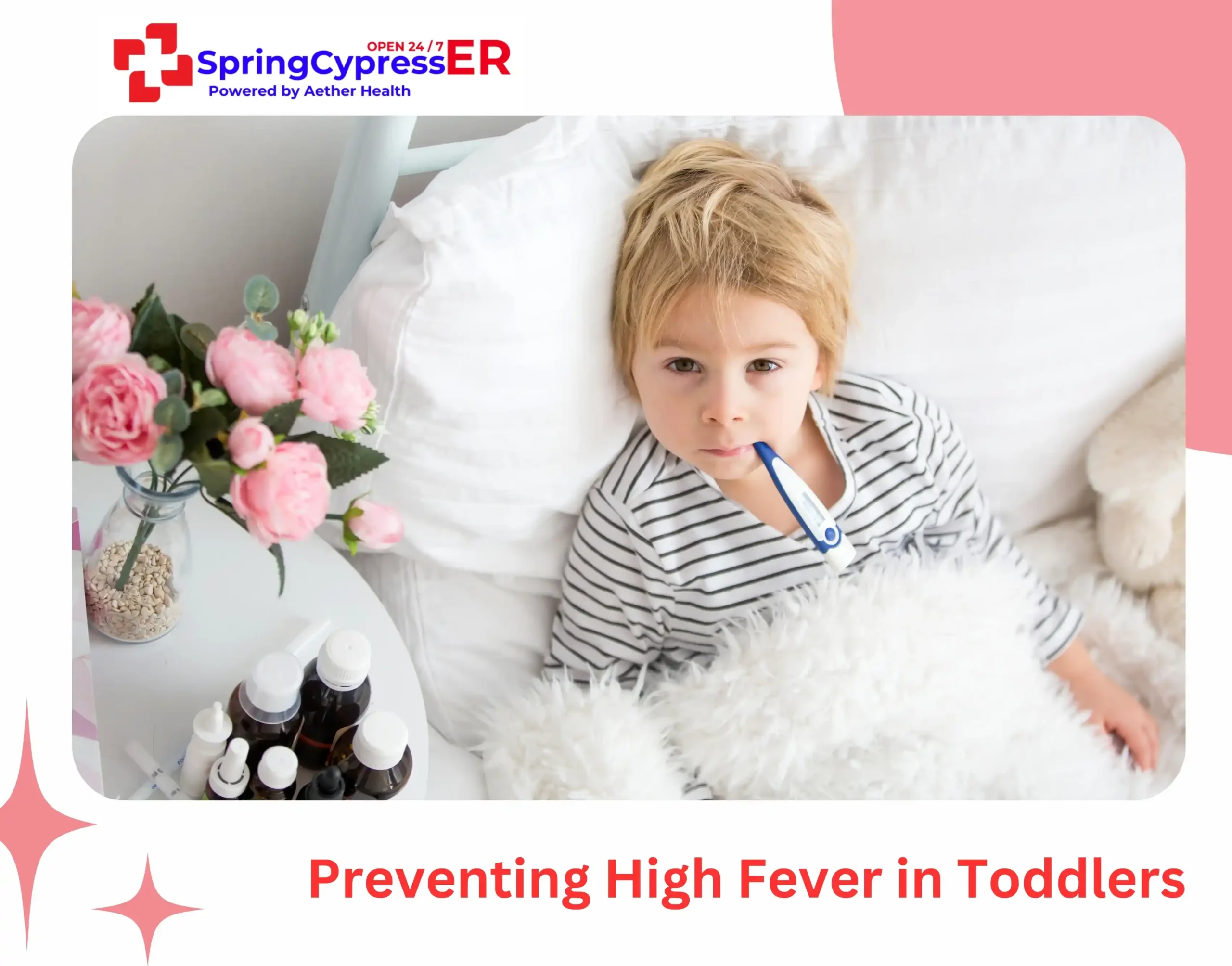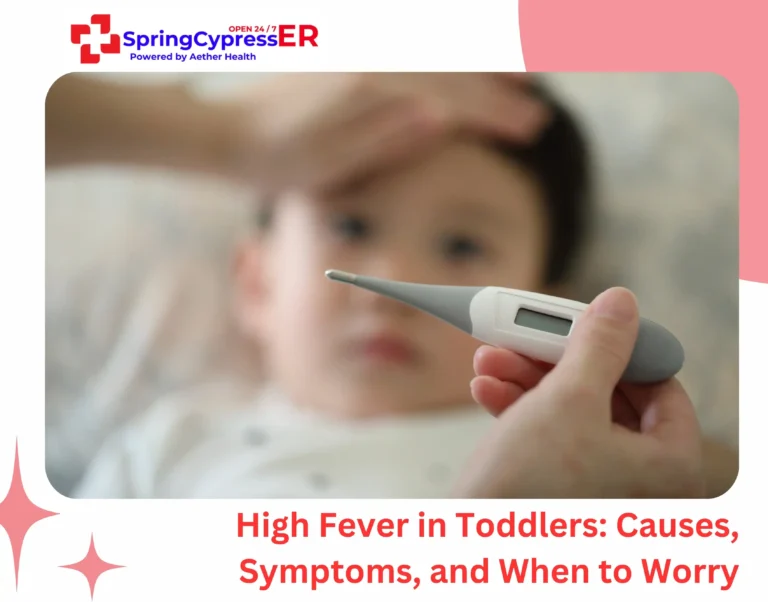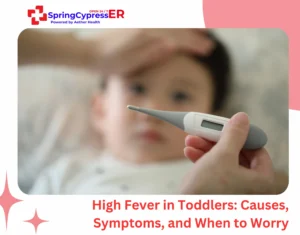Seeing a high fever in your toddler can be alarming, especially when your child feels weak or looks flushed. However, fever itself is not a disease — it’s a sign that your toddler’s immune system is fighting an infection. Understanding what causes high fever in toddlers, when to seek medical help, and how to provide home care can help you manage this common childhood symptom confidently.
What Is Considered a High Fever in a Toddler?

In toddlers (ages 1–3 years), fever is defined as a body temperature of 100.4°F (38°C) or higher. A high fever in toddlers usually means a temperature above 102.2°F (39°C).
- Mild fever:4–102.1°F (38–38.9°C)
- High fever:2–104°F (39–40°C)
- Very high fever: Above 104°F (40°C)
According to the American Academy of Pediatrics (AAP), the number on the thermometer is less important than your child’s overall condition and behavior. If your toddler is alert, drinking fluids, and playful between bouts of illness, the fever is less concerning.
Common Causes of High Fever in Toddlers
Most cases of high fever in toddlers are caused by infections. Some of the most frequent causes include:
- Viral infections – Such as colds, influenza, COVID-19, or roseola, which often cause fever lasting 3–5 days.
- Ear infections – Pain and tugging at the ears along with fever often indicate a middle ear infection.
- Respiratory infections – Pneumonia, bronchitis, or croup can lead to fever, cough, and breathing difficulty.
- Urinary tract infections (UTIs) – Common in toddlers, especially girls or uncircumcised boys.
- Teething – May cause a mild temperature rise, but typically not a true high fever.
- Post-vaccination fever – A mild to moderate fever can appear for up to two days after immunization.
Symptoms That May Accompany High Fever in Toddlers
A toddler’s high fever may come with several other symptoms depending on the cause:
- Chills and shivering
- Fatigue or irritability
- Cough, sore throat, or nasal congestion
- Poor appetite
- Muscle aches
- Rash (in some viral infections)
- Fast heartbeat or breathing
If your child has a persistent cough, difficulty breathing, or rash with fever, seek prompt medical attention.
How to Measure Fever Accurately in Toddlers
Rectal thermometers provide the most accurate readings for children under 3 years.
- Rectal temperature: Best for toddlers.
- Axillary (underarm): Useful for quick checks but less precise.
- Ear thermometers: Convenient but must be placed correctly.
Avoid mercury thermometers — digital ones are safer and easier to use.
When to Worry About High Fever in Toddlers
Most fevers are harmless, but certain warning signs mean it’s time to contact a doctor. Seek immediate medical help if your toddler:
- Is under 3 months old with a temperature ≥100.4°F (38°C)
- Has a fever above 104°F (40°C)
- Has a fever lasting more than 3 days
- Appears unusually lethargic, confused, or irritable
- Has trouble breathing, stiff neck, or persistent vomiting
- Develops a rash that doesn’t fade when pressed
- Shows blue lips or fingertips (signs of low oxygen)
Persistent high fever in toddlers unresponsive to fluids or fever medication requires medical evaluation.
Treating High Fever in Toddlers at Home
If your child’s fever is mild and they’re otherwise active, you can manage it safely at home.
1. Keep Them Hydrated
High fever increases fluid loss. Offer plenty of water, milk, or an oral rehydration solution. If your toddler is still breastfeeding, continue as usual.
2. Light Clothing and Cool Room
Dress your toddler in light clothes and keep the room around 70°F (21°C). Over-bundling traps heat and raises temperature further.
3. Encourage Rest
Rest helps the immune system fight infections. Provide a calm environment with minimal noise or light.
4. Fever-Reducing Medication
Use acetaminophen (Tylenol) or ibuprofen (Motrin, Advil) according to your child’s weight and age. Never give aspirin to children as it can cause Reye’s syndrome.
5. Lukewarm Baths
A gentle, lukewarm bath or sponge can make your toddler more comfortable. Avoid ice-cold water, which can trigger shivering and raise core body temperature.
When Emergency Care Is Needed
You should go to the emergency room if your toddler’s fever is associated with:
- Seizures (febrile seizures)
- Difficulty breathing or bluish skin
- Severe dehydration (no urine for 8+ hours, dry mouth, sunken eyes)
- Persistent vomiting or diarrhea
At the ER, doctors may perform tests such as blood work, urine analysis, or chest X-rays to determine the cause of the high fever.
Preventing High Fever in Toddlers

You can’t always prevent fever, but you can lower your child’s risk by:
- Keeping vaccinations up to date
- Practicing frequent handwashing
- Teaching your toddler to avoid touching their face
- Keeping them away from sick children
- Maintaining good nutrition and adequate sleep
According to the CDC, maintaining strong immunity and proper hygiene significantly reduces the risk of infections that commonly cause high fever in toddlers.
Possible Complications of High Fever

Although rare, prolonged or extreme high fever in toddlers can lead to:
- Febrile seizures (brief convulsions due to sudden temperature rise)
- Dehydration
- Lethargy or confusion
- Underlying bacterial infection, such as meningitis or pneumonia
Most children recover without complications when properly monitored and hydrated.
Key Takeaway
A high fever in toddlers is common and usually the body’s natural defense against infection. While most cases resolve safely with home care, you should always watch for red-flag symptoms like breathing difficulty, dehydration, or prolonged fever. Keep your child hydrated, comfortable, and consult your pediatrician when in doubt.
Frequently Asked Questions (FAQs)
1. What is considered a dangerously high fever in a toddler?
A temperature above 104°F (40°C) is considered very high. If your child also seems listless, difficult to wake, or has breathing trouble, seek emergency care immediately.
2. Can teething cause high fever in toddlers?
No. Teething may cause a mild temperature rise, but not a true fever above 100.4°F (38°C). High fever in toddlers is more likely due to infection.
3. Should I give medicine every time my toddler has a fever?
Not necessarily. Only give medication if your toddler is uncomfortable, refusing fluids, or has trouble sleeping. Fever helps fight infection.
4. Can a high fever cause brain damage?
Fevers caused by infection rarely cause harm. Brain damage generally occurs only if body temperature exceeds 107°F (41.7°C), which is extremely rare.
5. How long does a high fever in toddlers last?
Most viral fevers last 3–5 days. If the fever persists beyond that or keeps returning, consult your pediatrician to rule out bacterial infection or other causes.




